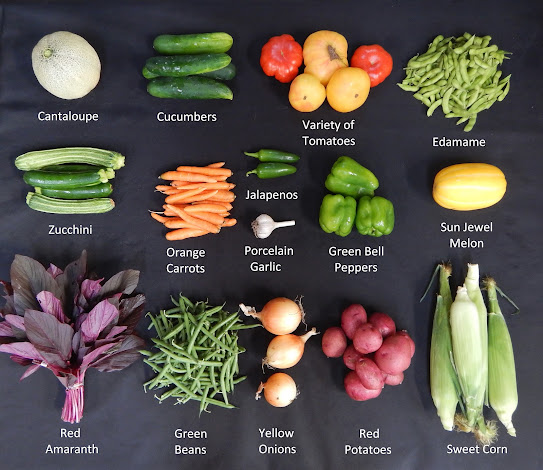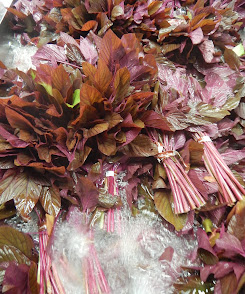Cooking With This Week's Box
Amaranth Greens:
.jpg) |
| Photo from ambitiouskitchen.com |
Red Cipollini or Sweet Spanish Onions:
Orange Carrots:
Zucchini:
Green and/or Silver Slicer Cucumbers:
Red New Potatoes:
.jpg) |
| Photo from poshinprogress.com |
Porcelain Garlic:
Variety Bag of Tomatoes:
Green Beans:
Edamame:
Sweet Corn:
Jalapeño Peppers:
Green Bell Peppers:
Sweet Sarah or Sugar Cube or French Orange Melon:
Sun Jewel Melon:
Hello All!
 |
| Red Lentil South with Amaranth Greens |
Ok, now let’s move on to this week’s featured vegetable which is Amaranth Greens. If you’re not familiar with this vegetable, please refer to this week’s feature article and don’t be intimidated by it! You can prepare it similarly to spinach and I think it is best prepared in a cooked manner when it’s at this stage of maturity. This is one of our favorite summer greens and it is packed with nutrition! This week’s featured recipe is for Jamaican Amaranth (See Below), which is a very simple, traditional way amaranth is prepared in the Caribbean and usually eaten as a side dish for breakfast or lunch. I consider this recipe to be a good base recipe, but if you’re not afraid to stray from tradition it may be adapted by adding additional vegetables such as green beans, edamame and sweet corn! Basically, this dish consists of quick-cooking stewed summer vegetables. It’s delicious served with scrambled eggs and/or rice. I also included several links to other recipes we’ve published previously that highlight Amaranth.
Another new vegetable in this week’s box is edamame! If this is your first time using this vegetable, you may want to take a moment to read our past Edamame Vegetable Feature
which includes cooking instructions. Once cooked, edamame are easy to use and can become quick and healthy snacks and meals. Check out these recipes for 5-Minute Edamame Snacks and Edamame Hummus, two good recipes for late summer travel food, lunch at work or back to school lunch options!
.jpg) |
| Photo from forkinthekitchen.com |
We’re in the peak of tomato and sweet corn season and there’s never a shortage of recipe ideas for ways to put these two summer favorites to use. Fresh Sweet Corn Salsa is a tasty use of corn and may be served with chips or use it to top off beef tacos or grilled fish or chicken. Double Bean & Corn Enchiladas is a family-friendly dinner option that could be assembled in advanced and then baked on the night you want to serve it. Roasted Tomato & Garlic Risotto is a dish you’ll want to make and serve, but will really showcase the fresh garlic and tomato flavors. Remember, tomatoes are actually a fruit so don’t be afraid to pair them with other fruit such as in this Tomato and Stone Fruit Salad!
If you want to try something a little different, creative and a taste from another culture, check out these recipes for 3-Ingredient Korean Melon Ice Cream Bars and Korean Melon Jam & Cream Cheese Pastries. Of course you can also just cut the melon and eat it right out of the rind!
I want to also mention there have been some great recipe shares in the Facebook Group over the past week, some of which I included in this week’s list of suggestions. If you’re feeling stuck and not sure what to do with a vegetable, check in with the group and I’m certain other members will offer suggestions for recipes to help you out!
Looking ahead, we’re hoping to include tomatillos and poblanos in your box very soon and possibly even next week! Of course, we’ve only just begun with sweet peppers, so you can expect some Italian Frying peppers and other sweet varieties very soon. In the meantime, have a great week and I hope you enjoy this week’s box of summer goodness!
-Chef Andrea
Vegetable Feature: Amaranth
by Andrea Yoder
Red Amaranth is a stunning “green” with dark, burgundy-colored leaves. Amaranth is also a grain. While the plant that produces grain is in the same family, they are not the same plants. Amaranth greens have become an important part of our seasonal diet because of their ability to grow in the heat of the summer when other greens, such as spinach and lettuce, do not thrive. Amaranth is adaptable to variable conditions with little impact from weather or disease. It can survive in extreme heat or drought conditions because it is able to convert twice the amount of solar energy using the same amount of water as most other plants! It is also worth mentioning that amaranth is a nutritional powerhouse. The leaves are rich in calcium, phosphorus, protein, vitamin C, carotene, iron, B vitamins, and trace elements including zinc and manganese. Compared to spinach, amaranth leaves have three times more vitamin C, calcium, and niacin! Of course, we know vegetables that have rich colors like the magenta leaves of amaranth are also packed with important phytonutrients and antioxidants. While we choose to grow this stunning dark red variety, there are other varieties of amaranth that have all green leaves and some that have green and red variegated leaf patterns. Amaranth is also known by other names including callaloo in the Caribbean and pigweed.
Amaranth is an ancient plant that was part of the diets of Aztec civilizations in Mexico up to 7,000 years ago. It was also an important staple food for the Incas of South America and the people of the Himalayan region of Asia. In these ancient cultures, amaranth was also used medicinally and in cultural rituals. It was held as a symbol of immortality and means “never-fading flower” in Greek. Amaranth has made its way around the globe as people have immigrated. Amaranth became an integral part of the cuisine in some parts of Africa and later spread more extensively around the world to the Americas, Caribbean, Brazil, India, and Asia in part facilitated by the slave trade. Thus, there are many different options for preparing amaranth depending upon the culture. This week’s featured recipe is actually a traditional way amaranth is prepared in the Caribbean where it is a staple vegetable cooked very simply and eaten as a side dish for breakfast or lunch.
While amaranth may be eaten either raw or cooked, I think it tastes best when cooked when it is at this stage of maturity. The flavor of cooked amaranth is similar to spinach, except better! You can prepare it as you would spinach or other similar greens such as chard. The stems and leaves are both edible. I learned something new this year in my research. Previously I had discarded the thick main stem and only used the thinner more tender stems. However, several different sources indicated the thick stems should be peeled. I did this and was surprised to find the inner part of the stem is quite tender and delicious. It’s a bit of a tedious job, but if you use a small paring knife it’s manageable and will maximize the yield. Amaranth greens may be steamed, sautéed, added to soups, stews, wilted and stir-fried and cook quickly in just a few minutes. Amaranth pairs well with so many other summer crops including onions, fresh garlic, zucchini, peppers, corn, green beans, edamame, basil, oregano, and tomatoes.
Store amaranth greens in the refrigerator in a plastic bag until you are ready to use them. Remove the twist tie and wash well in a sink of cold water before using. Shake or spin off excess water.
Jamaican Amaranth
1 bunch amaranth greens
1 Tbsp vegetable oil
1 medium onion, small dice
1-2 cloves garlic, minced
½-1 jalapeño pepper, minced
2 cups diced fresh tomatoes
2 Tbsp water
2-3 sprigs fresh thyme or 1 tsp dried thyme
1 tsp Salt, plus more to taste
Black Pepper, to taste
- First, prepare the amaranth greens. Remove the leaves and tender stems from the thicker main stem. Cut the leaves into thin, bite-sized pieces and finely chop the stems. Using a small paring knife, carefully peel the outer layer off the thicker stems to reveal the tender green inside. Finely chop the stems. Place the chopped amaranth in a bowl and cover with cold water. Stir in 1 tsp salt and mix it in. Set aside while you prepare the remaining vegetables.
- In a large sauté pan, heat the vegetable oil over medium heat. When the oil shimmers, add the onion, garlic, and jalapeños to the pan. Sauté until the onion is softened and translucent. Add the tomatoes, 2 Tbsp water and thyme. Drain the water off the amaranth and rinse them in a colander. Add the amaranth to the pan. Season with salt and black pepper.
- Simmer the vegetables over medium to medium high heat for 5-10 minutes or until all vegetables are tender and some of the liquid has reduced. Add additional salt and black pepper to your liking.
- Serve hot as a side dish for breakfast or lunch. You may also wish to eat it with cooked rice or steamed fish.
Note from Chef Andrea: I adapted this recipe slightly from www.healthiersteps.com/recipe/jamaican-callaloo. The original recipe called for a Scotch Bonnet pepper instead of a jalapeño. I am not brave enough for a Scotch Bonnet and we have jalapeños right now, hence the substitution. You can adjust the level of spice to your liking by using an appropriate quantity of jalapeño. This is a simple dish, but I consider it a good base recipe that you can build upon. While it may not be traditional to Jamaican cuisine, this dish would also be good with the addition of other summer vegetables including fresh sweet corn, green beans and/or edamame. Don’t be afraid to add to it!




No comments:
Post a Comment